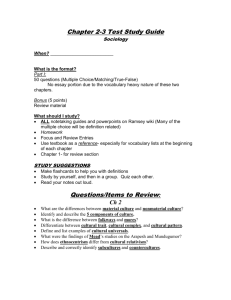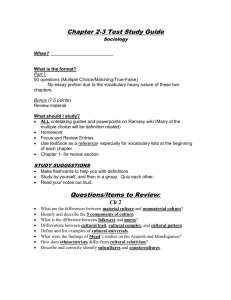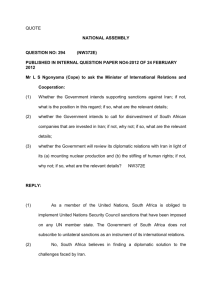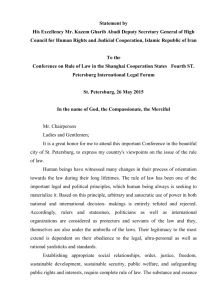soussan_steptoe
advertisement
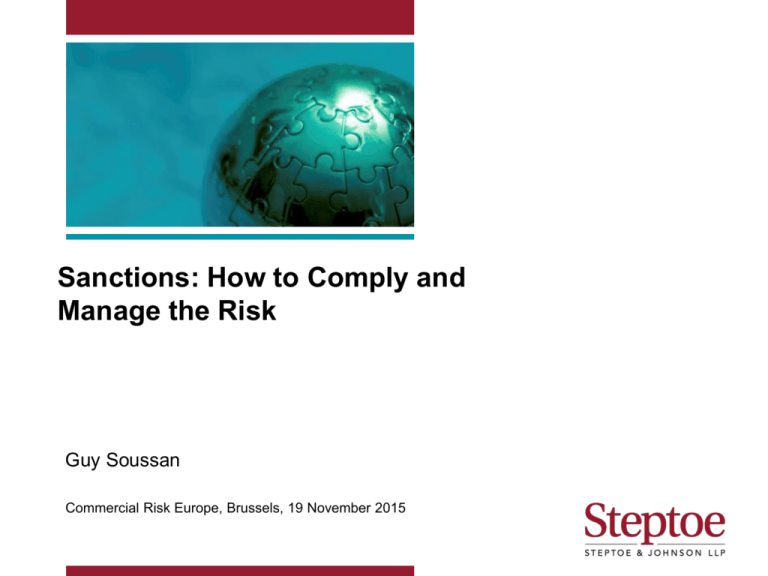
Sanctions: How to Comply and Manage the Risk Guy Soussan Commercial Risk Europe, Brussels, 19 November 2015 Agenda Overview of general EU sanctions Overview of EU sanctions specific to (re)insurance US sanctions overview and enforcement US and EU sanctions relief to Iran (JCPOA) Due diligence and risk mitigation 2 EU: Sanctions Programs Overview Selected target countries Types of restrictions Crimea Asset freeze Ivory Coast Trade ban (import/export) Egypt Investment and financing ban Libya Restrictions on financial services Iran Restrictions on transport North Korea Arms embargo Russia Travel ban Syria Enhanced customs formalities Tunisia Others Zimbabwe 3 Why EU Sanctions Apply to You? Your nationality/ domicile of your legal entity The parties involved in your transaction The subject matter of your transaction The existence of financial services restrictions 4 Your Nationality/ Domicile Any entity incorporated in an EU Member State and its EU and non-EU branches Any entity incorporated outside the EU, but only with respect to business conducted in the EU Any individual resident in the EU, irrespective of nationality Any EU national even if resident outside the EU 5 Your Transaction involves “Designated Natural or Legal Persons” EU persons and entities cannot provide “economic resources” and are required to freeze any property belonging to them that come under their control The EU defines as “Designated Natural or Legal Persons” (“DP): (I) Persons or entities explicitly listed in Annexes to EU Regulations (II) Entities with a total ownership of 50% or more by those designated (III) Entities they control or those acting on their behalf Note: (II) and (III) are not expressly listed 6 The Object of your Transaction is Restricted Examples Ban on export, import, transport, brokering of banned items Ban on related technical assistance Ban on goods of EU and target country origin Banned items – – – – – – – Arms and internal repression equipment WMD-related Crude oil and petroleum products Key equipment for oil and gas Dual use goods Luxury items Others 7 The Existence of Financial Services Restrictions Restrictions on investment – Financial loans or credit – Acquisition or extension of shareholdings – Creation of joint ventures – Participation in infrastructure projects Restrictions on (re)insurance Restrictions on transfer of funds Restrictions on access to capital markets 8 Main Challenges for the EU Industry Room of different interpretation and application among Member States Ownership of the other parties to the transaction Use of the goods, services, or technology Legal uncertainty linked to judicial challenges to EU listing Potential extra-territorial application of sanctions regimes of other jurisdictions (e.g. the US) 9 Specific (Re)Insurance-related Sanctions (Re)insurance of listed individuals/entities (Re)insurance for – Sale of military items – Sale of listed technologies suited for oil industry Brokering (re)insurance as above Export credit (re)insurance 10 How can EU Insurers be Liable under EU Sanctions? Providing coverage to benefit listed individuals/entities or targeted industry sectors, such as: – directors and officers liability – marine and marine cargo insurance – international transportation insurance – export credit insurance – technical insurance – Offshore construction (CAR) Providing a service (e.g., claims processing, risk management, actuarial etc.) Collecting premiums or paying out claims in relation to prohibited coverage Brokering the coverage or facilitating a service or risk transfer 11 Particular Challenges For EU (Re)Insurers Ultimate knowledge of the named and effective (re)insured, their intermediaries, and other identifiable parties who benefit from cover Defining the targeted entities which are ultimately owned of controlled by other listed entities and persons – Reluctance of EU Regulations to provide an exhaustive list of all targeted entities – ownership: 50% of proprietary rights or majority interest – control: right to exercise certain powers Open payment terms v. extended credit or loans 12 Key Differences: EU and US Sanctions Regimes US regime is more comprehensive regarding certain countries and blocked persons (i.e., generally all business is restricted) US federal/state governments can enforce high penalties against actions undertaken willfully (criminal) or with no intent (civil) Non-US persons have received significant penalties for allegedly violating US sanctions for conduct primarily undertaken outside US EU regime is more targeted against persons and not on a country wide basis (i.e., certain sectors in Iran and Syria have been restricted) Civil standard does not exist in EU EU enforcement is left to Member States – not as vigorous enforcement as seen in US No real EU corollary to US approach seeking to deny US markets to foreign persons undertaking certain actions related to Iran and Syria 13 Four Basic Types of US Sanctions 1. Comprehensive Sanctions • Very broad restrictions against a country, government, and its nationals • Currently: Cuba, Iran, Sudan, Syria, and Crimea region of Ukraine 2. Targeted Country or Regime-Related • The entire country is not prohibited, but certain persons/government officials are • Often related to violence, human rights abuses, and other destabilizing acts • A hybrid regime applies to Russia 3. Targeted Activities or Issues-related • Restricts persons, organizations and entities for certain reasons/issues • Can relate to terrorism, weapons proliferation, narco-trafficking, transnational criminal organizations, human rights abusers, etc. 4. Secondary Sanctions • Restricts activities of non-US persons • Currently: Iran, Russia (certain sectors), Syria (limited extent) 14 Who must comply with US “Primary” Sanctions US “primary” sanctions apply to: – US citizens and permanent residents, wherever located (including abroad) – All persons in the United States (e.g., non-US persons visiting/working temporarily) – All businesses or organizations located in the United States and their foreign (non-US) branch offices – Foreign (non-US) subsidiaries of US organizations relating to trade with Cuba and Iran 15 Who must comply with US “Secondary” Sanctions “Secondary” sanctions explicitly apply to non-US persons – Seek to restrict non-US persons from engaging in certain types of business with certain sanctioned countries (currently Iran and Russia, and to a lesser extent Syria) – Enforced by US State Department, in consultation with OFAC Non-US financial institutions have been subject to significant civil and criminal enforcement actions 16 General Restrictions on US persons US person are prohibited from exporting, reexporting, and transshipping – directly or indirectly – to a sanctioned country, government, or person: – – – Goods (e.g., commodities, materials, equipment, etc.) Technology or software Services (can include know-how and technical assistance) Financial transactions or funds transfers (or brokering such transactions) Most sanctions also prohibit reexportation by foreign persons to sanctioned countries of most US-origin goods, software, or technology 17 License exceptions, general licenses or specific licenses may be available Specially-Designated Nationals (SDNs) Cannot engage in transactions or dealings with persons designated as SDNs, or otherwise deal in “property or interests in property” of SDNs SDN list published on OFAC website, as well as archived changes, currently with over 6000 names (http://www.treas.gov/offices/enforcement/ofac/sdn/) In general, SDN property that comes under control of US persons must be blocked, held in interest-bearing accounts, and reported to OFAC within 10 days Any entity owned or controlled 50% or more by a SDN, but not specifically designated by OFAC, is deemed to be blocked Cannot provide material, financial, or technical support to SDNs 18 US Enforcement Actions OFAC investigations DOJ criminal enforcement actions State enforcement actions Notable Enforcement actions against non-US persons 19 Schlumberger Settlement Schlumberger Oilfield Holdings Ltd. (SOHL) – BVI company – Schlumberger Drilling & Measurements (D&M), a Texas-based business unit of parent company Schlumberger Ltd., provided services to customers in Iran and Sudan through SOHL’s non-US subsidiaries – D&M employees in the United States: • Approved capital expenditures to manufacture and purchase equipment for Iran and Sudan. • Made business decisions relating specifically to Iran and Sudan • Provided technical services for equipment in Iran and Sudan – D&M employees considered “US persons” when located in the United States, even if non-US citizens – SOHL charged with conspiring with D&M to violate sanctions laws – Broad jurisdictional reach of criminal conspiracy statute – $232.7 million settlement with DOJ and BIS: $77.6 million forfeiture, $155.1 million criminal fine 20 US Enforcement Cases against Non-US Banks ABN Amro: – Jan. 2006: $40M (OFAC, Federal Reserve) – May 2010: $500M (DOJ) Lloyds Bank TSB, Jan. 2009: $350M (DOJ, DANY) Australia and New Zealand Bank Group, Aug. 2009: $5.75M (OFAC) Credit Suisse, Dec. 2009: $536M (DOJ, OFAC, Federal Reserve, DANY) Barclays, Aug. 2010: $298M (DOJ, OFAC, DANY) ING Bank, N.V., June 2012: $619M (DOJ, OFAC, DANY) Standard Chartered Bank: – Dec. 2012: $327M (DOJ, OFAC, Federal Reserve, DANY) – Aug. 2012: $340M (NYDFS) HSBC, Dec. 2012: $1.9B (DOJ, OFAC, Federal Reserve, OCC, DANY) RBS, Dec. 2013: $100M (OFAC , Federal Reserve, NYDFS) Bank of Moscow, Mar. 2014: $9.4M (OFAC) Commerzbank, Mar. 2015: $1.45B (DOJ, OFAC, Federal Reserve, DANY, NYDFS) Credit Agricole, Oct. 2015: $787M (DOJ, OFAC, DANY, NYDFS, Federal Reserve) 21 Paribas Settlement Arranged dollar clearance in the United States of Sudan-related transactions, actively concealing the involvement of Sudanese entities – Unaffiliated “satellite” banks transferred funds through the US financial system for Sudanese beneficiaries – Payment instructions did not refer to Sudanese entities Arranged dollar clearance for Cuban entities – Cuban entity would transfer funds to BNP account at an unaffiliated bank – BNP transfer funds from unaffiliated bank to a “transit account” within BNP Paris– this resulted in dollar clearance through New York – BNP then transferred funds from transit account to Cuban account within BNP Engaged in Iran-related “U-turn” transactions after OFAC revoked authorization for such transactions Principal theory of liability: export of financial services from US $8.973 billion penalty: forfeiture of $8.833 billion, $140 million fine Federal and state regulators involved, criminal and civil Dollar-clearing restrictions – first time imposed as remedy 22 Enforcement Actions against (Re)Insurers Facilitating the placement of coverage and the payment of premiums for facultative retrocession reinsurance for construction risks associated with a petroleum project on Kharg Island in Iran. Brokering and placing facultative retrocession reinsurance in Iran on behalf of a foreign reinsurer with European retrocessionaires. Making reinsurance claim payments to a shipping association for losses arising from vessel operations of the National Iranian Tanker Company Note: The New York Department of Financial Services has become more active in seeking information about sanctions compliance from insurers operating under NY state law – independent from OFAC actions 23 The Iran Deal Highlights Joint Comprehensive Plan of Action (JCPOA) of July 14, 2015 – Participants: the US, UK, Germany, France, Russia, China, and Iran – Will provide some limited sanctions relief in exchange for Iran ending its military nuclear program – Has survived certain US Congressional efforts to reject it NO JCPOA SANCTIONS RELIEF HAS GONE INTO EFFECT YET! – Certain sanctions will be suspended when the International Atomic Energy Agency (IAEA) verifies Iranian steps – Implementation Day – However, most primary US sanctions will remain in force – Actual Implementation Day is uncertain – not likely until 2016 24 Timeline of Important Dates The Iran Deal is a series of important milestones: the most important is Implementation Day next year when certain US secondary sanctions and most EU primary sanctions will be suspended Date July 14, 2015 July 19, 2015 July 20, 2015 August 15, 2015 September 14, 2015 September 20, 2015 October 18, 2015 (approx.) Early to Mid 2016 (TBD by IAEA) July 2023 (approx.) Description “Finalization Day”: Negotiations end and the JCPOA is signed by representatives of the U.S., its negotiating partners, and Iran State Department delivers to Congress the JCPOA, the annexes, and the unclassified verification assessment report on Iranian compliance with earlier agreements with its classified intelligence community’s annex for review U.N. Security Council approves and endorses the JCPOA Deadline for Iran to supply IAEA with explanation and documents related to PMD** of Iran’s past nuclear activity Deadline for IAEA to review and submit questions to Iran concerning PMD** issues Last day for Congress to act on review of JCPOA (deadline has already passed) “Adoption Day”: 90-day delay in substantive action designed to give Congress a 60-day review period and Iranian parliament time for study and ratification of all elements; deadline for Iranian parliament to agree to the Additional Protocol (occurred on 10/13/2015); EU passes regulation to take effect on Implementation Day, suspending economic and financial sanctions on Iran; President Obama begins process of suspending by waiver some financial, insurance, and energy sanctions against Iran – to take effect on Implementation Day “Implementation Day”: Deadline for IAEA to resolve all outstanding PMD** issues; at this time all Iran nuclear-related controls kick in and sanctions on Iran are removed, subject to compliance by Iran “Transition Day”: Legal ending of sanctions by US; Iran will seek ratification of the Additional Protocol from parliament 25 US and EU Sanctions Relief to Iran - Lack of Uniformity Virtually all EU sanctions will be removed Most primary US sanctions against Iran will remain Some, not all US secondary sanctions will be removed Due diligence and careful dealing with global financial institutions will be needed by non-US persons 26 JCPOA: EU Sanctions Relief EU will eventually lift the majority of its sanctions targeting Iran Restrictions may still apply to Iranian persons or entities specifically designated by EU Removal of parallel banking restrictions on transfer of funds for payment of premiums and claims Sanctions to be removed on providing insurance or reinsurance to Iran, the GOI, or Iranian – Lift EU sanctions in place on (re)insurance for any sale, supply, transfer, import or export of oil, gas, petrochemical products, shipping, shipbuilding and transport sectors 27 JCPOA: Not all US Sanctions will be Lifted The JCPOA agreement does not automatically lift sanctions on Iran. The announcement of the JCPOA does not mean that US persons and entities can immediately do business with or invest in Iran. – US Primary sanctions that apply to US persons will continue. – Only certain of the secondary sanctions applicable to non-US persons will be suspended on Implementation Day. The bottom-line is that for now, US persons, and non-US entities owned or controlled by US persons, still are prohibited from participating in or facilitating nearly all energy-related transactions involving Iran. – Premature action re Iran market can result in penalties 28 US Sanctions – JCPOA Relief for Non-US Persons on Implementation Day “Suspends” secondary US sanctions that otherwise restrict nonUS persons from doing business with certain Iranian sectors and persons: – Crude oil, refined petroleum, petrochemicals trade and investment – Banking, Iranian sovereign debt/rials, and US banknotes – Shipping, shipbuilding, & ports – Automotive; precious metals; coal, aluminum, steel, other raw materials; – Software for industrial processes;. – Certain entities, persons, and vessels identified in JCPOA no longer designated Non-US persons can provide banking, underwriting services, insurance, or reinsurance services (and “associated services”) for the foregoing Note: “Non-US persons” does NOT include non-US entities “owned or controlled” by US persons 29 EU/US Sanctions: Identifying and Managing Risks Common mistakes Outdated or insufficient internal guidance/training − − Does not identify current prohibitions Does not implement controls/training to mitigate risks Failure to follow internal procedures − Requesting additional information; escalation Human error − − Determining whether potential matches are false Miscommunication Misinterpreting EU/US sanctions legislation and guidance Due diligence and screening − − Failure to update/monitor for changes and new designations Automatic exceptions in screening filter 30 Identifying and Managing Risks (cont’d) Determine the level of risk you are willing to accept Ensure your policies are sufficient to manage that risk – Once you determine your risk tolerance, ensure policies are set accordingly – Ensure policies cover all personnel involved (management, business teams, compliance staff, and others) Train, train, train – If a violation occurs, the fact that you have invested in training will be a mitigating factor Audit – Policies/procedures are never perfect – auditing can help spot holes 31 Compliance Considerations De-Risking Nuanced Compliance • Self-imposed limitations on potential business • Engagement with countries subject to sanctions to the extent permitted Very common today Goes beyond what is required under the law Can involve more simple compliance assessment Can result in loss of legitimate business; upset customers Requires complete and nuanced understanding of the law More complicated compliance mechanisms Well-trained experts to assess compliance decisions Can provide for market opportunities 32 US SDN/EU DP List Screening Screening is one of the most important compliance steps, but is not required by law A prudential measure to help prevent violations from occurring Transactions with customers, vendors, brokers, and other business partners should be screened against the SDN List/EU DP List Screening procedures, and records showing evidence of SDN/DP screens, should be documented and followed Screening should be conducted by designated personnel in the functional areas, as appropriate, prior to any transaction occurring Positive hits or questions should be immediately reported to the Legal/Compliance Department and should not proceed unless cleared 33 Risk Mitigation Steps with Counterparties Obtain certification/ representations/ warranties from counterparties Require screening by distributors and agents Review option to terminate or suspend contracts Assess compliance by major customers Build compliance terms into contractual arrangements 34 Risk Mitigation Steps – Sanctions Clause Does not replace due diligence Intended purpose of sanction clause – Implement statutory prohibition into contract – Clarity on legal positions regarding contractual effect of economic sanctions to avoid legal disputes Inherent limitations – may not be accepted by counter-parties and may not cover all of them – different forms with varying degree of legal certainty – enforcement affected by the choice of law/jurisdiction of the contract concerned 35 Risk Mitigation – Internal Controls Why conduct a review? − Audits/self-assessments are an important mechanism to verify compliance with the law and corporate policies − Can be scheduled/unscheduled, transaction-specific or enterprise-wide − Entities frequently adopt a risk-based approach Why conduct an investigation? − Internal or external audits, or routine monitoring or compliance − Employee notification of potential violation − US government subpoena − Risk of disclosure (e.g., whistleblowers, third parties, external audits) − Obligation to disclose misconduct (e.g., audits, licensing, reporting) 36 For Further Information Guy Soussan Steptoe & Johnson LLP +32 2 626 05 35 gsoussan@steptoe.com 37
